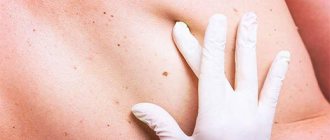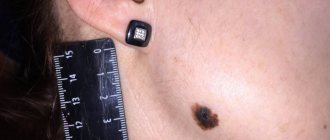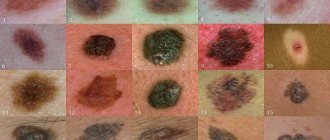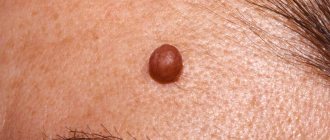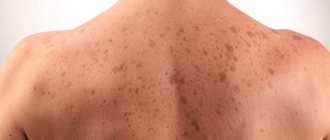First signs of danger
It is not always possible to immediately recognize which moles are truly dangerous to health, even from a high-resolution photo. However, a change in the shape or color of the nevus, the appearance of new formations, or loss of hairs from the nevus may indicate danger.
Types and symptoms
An increased amount of melanin in skin cells causes the appearance of benign, round-shaped spots. They can have different shades - from light brown to black.
Flat brown nevi can be found on any part of the body. Usually they are not numerous and remain unchanged in shape and color throughout life. They are distinguished from ordinary freckles by a more saturated and darker shade.
In people with blond or red hair or pale skin, melanocytes produce pink or red pigment. Therefore, their moles will be the same.
On this topic
- Moles
All about dangerous moles
- Inna Viktorovna Zhikhoreva
- September 27, 2020
In childhood and adolescence, multiple brown spots appear, which are commonly called lentigo. Their number may increase with age or under the influence of ultraviolet radiation.
“Mongolian spot” is diagnosed in newborns. It has a blue or gray tint, and reaches from 1 to 10 cm in size. Most often, the formation is located in the lumbar region, on the buttocks and thighs. Typically, this pathology disappears by the age of 1–2 years, and in rare cases, dull spots are observed in adults.
Among flat capillary moles, the following types are distinguished:
- Vascular malformation. It refers to a congenital pathological abnormality in the development of blood vessels. This group includes birthmarks in infants that are pale red in color on the neck or back of the head, which disappear over time. In addition, a child may be born with a “port wine stain” on the face, torso or arms. Such formations remain for life.
- Hemangioma. Appears on the body immediately after birth. It has a rich red color and benign character. Sometimes such a mole rises slightly above the skin. It usually develops on the neck and face. This type of nevus does not disappear on its own over time.
With age-related changes in the skin, senile flat moles appear. They are mainly located on the hands and face. In appearance they resemble freckles. In such cases, there is no risk of cancer.
Feasibility of removal
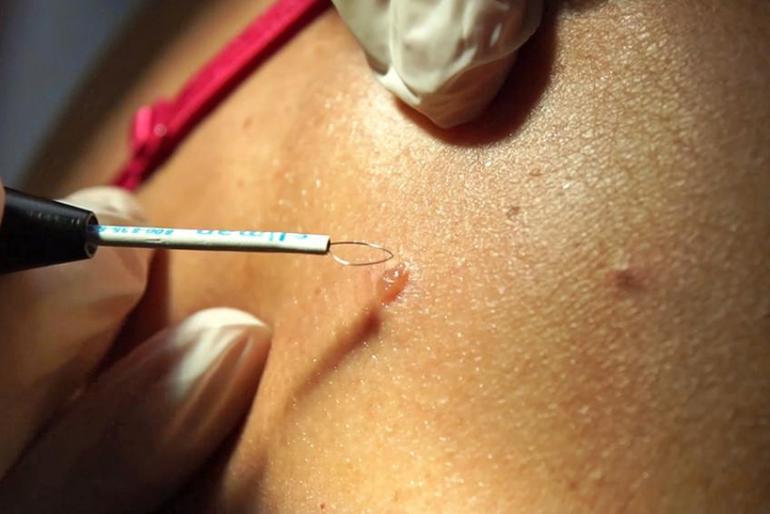
Understanding the dangers of moles on the human body, you can get motivation for a more careful attitude to health. It is not necessary to remove all potentially dangerous moles. If there are many of them, it is recommended to digitally image these objects. This is a method in which photographs are compared in a computer program to assess the risk of malignant transformation of each one.
In case of high oncogenicity, surgical removal is indicated. Otherwise, the formation can be monitored and re-examined every three to six months. But when it is located in an area subject to friction (under a bra strap, on the soles of the feet, under the armpit), monitoring is recommended, as malignant degeneration is likely.
Diagnosis of moles
In order to decide whether to remove a mole, the doctor examines and examines it.
First, the doctor conducts a visual examination - regular and using a dermatoscope. If oncology is suspected, it is advisable to conduct a histological examination, but it is impossible to take a biopsy from such formations, since trauma is dangerous due to a sharp progression of the oncological process. Therefore, in such cases, smears are taken from the surface of the nevi for histology if they have cracks and areas of bleeding. They are then examined under a microscope.
In recent years, computer diagnostics of pigmented lesions has become popular, but due to the high cost, this service is provided only in some clinics.
What are moles
In medicine, moles are called nevi. These are benign skin formations formed by normal skin cells with varying levels of melanocytes in them. Melanocytes are responsible for the color of moles. In color they can be red, pink, beige, brown and even black.
Nevi can be congenital or acquired. Congenital moles are essentially defects of embryonic development. They are not visible immediately after birth, since melanocytes do not yet contain pigment or very little of it. They begin to appear at 2-3 months as coloring substances accumulate in them. Such formations grow with a person and become larger and darker over time.

Acquired nevi can appear throughout life. Their occurrence is stimulated by ultraviolet radiation, hormonal changes in the body, skin injuries and other phenomena. Most new moles appear during puberty, pregnancy, and menopause due to pronounced changes in the amount of hormones in the blood.
Nevi can be localized not only on the skin, but also on the mucous membranes - in the mouth, on the tongue, in the genital area. This arrangement of moles is more typical for women.
Almost all nevi are benign skin tumors and do not pose any danger to human life and health. But sometimes they degenerate into cancerous formations, and then they require treatment. Therefore, some moles need to be removed in advance to reduce the likelihood of their malignancy.
Prevention measures
What to do to prevent inflammation? People who have a genetic predisposition to cancer have a greater chance of benign moles degenerating into melanoma. If you take the following precautions, you can avoid cancer:
- Avoid ultraviolet rays. Spending a long time in the sun or visiting a solarium is fraught with health risks, especially for a child. Scientists say that ultraviolet rays are now no less dangerous than the use of nicotine and drugs. Long-term sunbathing and frequent visits to the solarium lead to the development of cancer cells and the degeneration of moles;
- Clothes should not fit tightly to the body; it is advisable to give preference to natural materials so that the clothes do not rub the birthmark. A nevus located under tight clothing can become injured, which will lead to inflammation of the pigment spot;
- refusal of hard washcloths and brushes. They can damage not only the mole, but also cause microtrauma to the skin, which can give rise to the development of melanoma;
- During pregnancy, as well as in adolescence, it is necessary to monitor hormonal levels. An uncontrolled surge of hormones can lead to hormonal disruption, which can lead to the degeneration of skin tumors into malignant tumors.
Now you know that you can’t turn a blind eye to an inflamed mole. It is worth paying due attention to your health and going to the doctor after the first symptoms of inflammation appear. Then the problem of skin diseases will bypass you.
Connection with oncology
Melanoma usually develops from dangerous moles. But scientists cannot say whether the tumors acquired as a result of injuries and increased sun exposure are benign or malignant, or whether the disease only affects those who are predisposed to developing a tumor.
Less serious types of skin cancer (basal and squamous cell carcinomas) are not associated with moles. Many people are embarrassed by large moles on the body. It doesn’t hurt to know why they are dangerous , because healthy formations should not exceed 6 mm in diameter.
Treatment Basics
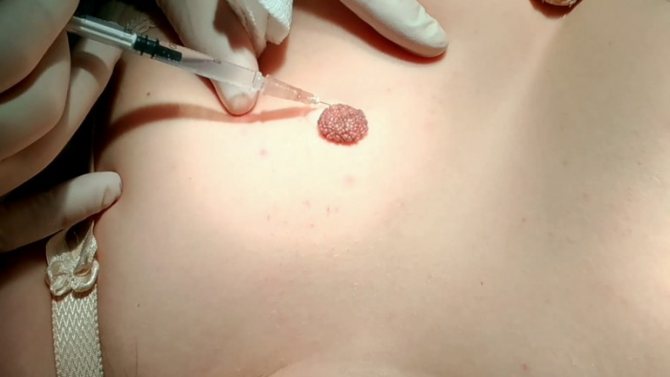
The main thing is to remove the mole and part of the surrounding tissue. Depending on the stage of the tumor (assessed in a laboratory), chemotherapy and immunotherapy may be prescribed.
There are external signs that you can focus on. If you conditionally divide the formation in half, both sides should be symmetrical. Asymmetry, when these imaginary halves do not match, is a warning sign of melanoma.
Moles should have smooth, even edges. In the case of early melanoma, the borders tend to be indistinct. They may be intermittent or jagged.
Common skin lesions are only one color. The range of shades (brown, black) is also a warning sign. Melanoma may change and appear red, white, or blue.
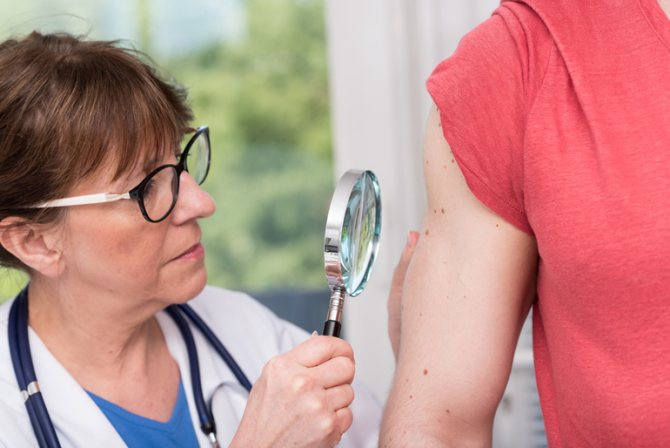
Non-malignant objects are usually smaller in diameter. On the other hand, they have a diameter of more than 6 mm, but may be smaller at first. You should see a doctor if they:
- change color, shape, size and relief;
- bleed;
- itchy;
- have a bumpy surface.
Skin cancer is the most common type of cancer and originates from the cells that make up the skin. There are many types of dermal neoplasms. In practice, they are divided into two main groups.
Malignant melanoma
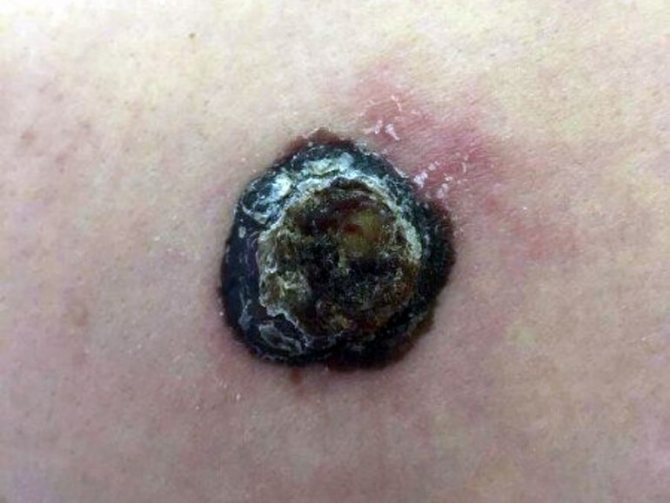
A dangerous cancer that originates from the cells of the skin pigmentation system, that is, melanocytes, which are responsible for tanning after exposure to the sun. In rare cases, the disease can form in the eyes, respiratory tract, intestines, brain and mucous membranes.
When it comes to melanoma, the chances of survival depend primarily on proper and early diagnosis and treatment. Timely evaluation and surgical removal at the initial stage of invasion is usually effective for most patients.
The primary task facing clinicians is to identify and remove the tumor, and the most important prognostic factor is tumor thickness. Even with advances in chemotherapy and immunotherapy, treatment success in advanced disease remains limited and the prognosis of its metastatic form is unpredictable.
Other types of neoplasms

This group includes basal cell carcinoma, or basal cell carcinoma, and squamous cell carcinoma. They are generally less dangerous but can have a poor prognosis if not treated early.
Skin cancer can target people of all ages, but is more common in older patients. However, people who are exposed to large amounts of solar radiation may experience the disease as early as 20/30 years of age.
Causes of moles
Different people have different propensities for developing moles. Some have many such formations, while others have a single number of nevi. What does this depend on?
There are several reasons for the appearance of moles:
- heredity;
- hormonal background;
- ultraviolet radiation;
- frequent skin trauma;
- some viruses and bacteria;
- X-ray and radiation.
The predisposition to the appearance of moles is genetic, but the extent to which it is realized depends on external factors.
